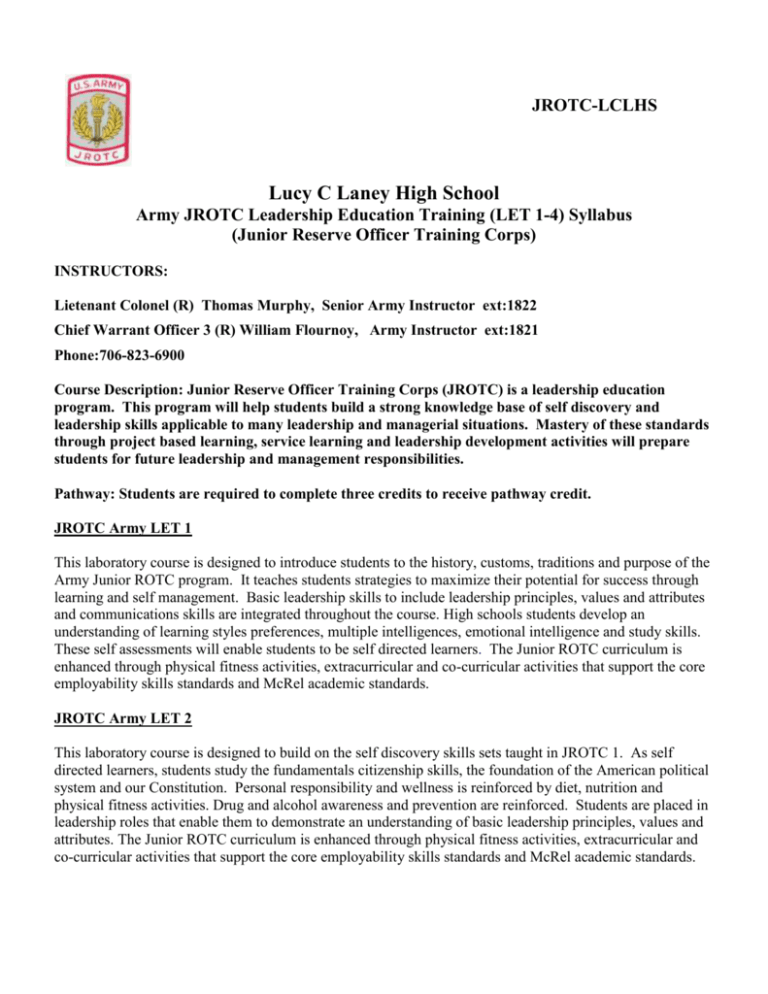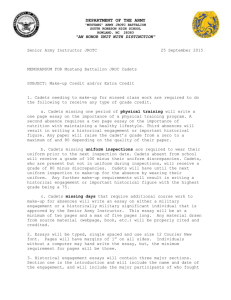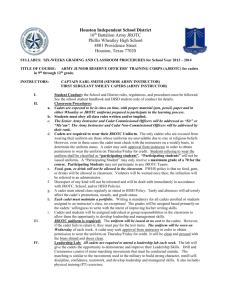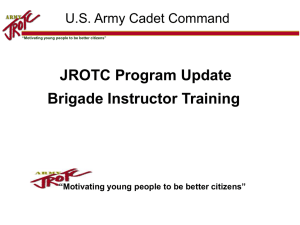Army JROTC Leadership Education Training 1 (JROTC I) Syllabus
advertisement

JROTC-LCLHS Lucy C Laney High School Army JROTC Leadership Education Training (LET 1-4) Syllabus (Junior Reserve Officer Training Corps) INSTRUCTORS: Lietenant Colonel (R) Thomas Murphy, Senior Army Instructor ext:1822 Chief Warrant Officer 3 (R) William Flournoy, Army Instructor ext:1821 Phone:706-823-6900 Course Description: Junior Reserve Officer Training Corps (JROTC) is a leadership education program. This program will help students build a strong knowledge base of self discovery and leadership skills applicable to many leadership and managerial situations. Mastery of these standards through project based learning, service learning and leadership development activities will prepare students for future leadership and management responsibilities. Pathway: Students are required to complete three credits to receive pathway credit. JROTC Army LET 1 This laboratory course is designed to introduce students to the history, customs, traditions and purpose of the Army Junior ROTC program. It teaches students strategies to maximize their potential for success through learning and self management. Basic leadership skills to include leadership principles, values and attributes and communications skills are integrated throughout the course. High schools students develop an understanding of learning styles preferences, multiple intelligences, emotional intelligence and study skills. These self assessments will enable students to be self directed learners. The Junior ROTC curriculum is enhanced through physical fitness activities, extracurricular and co-curricular activities that support the core employability skills standards and McRel academic standards. JROTC Army LET 2 This laboratory course is designed to build on the self discovery skills sets taught in JROTC 1. As self directed learners, students study the fundamentals citizenship skills, the foundation of the American political system and our Constitution. Personal responsibility and wellness is reinforced by diet, nutrition and physical fitness activities. Drug and alcohol awareness and prevention are reinforced. Students are placed in leadership roles that enable them to demonstrate an understanding of basic leadership principles, values and attributes. The Junior ROTC curriculum is enhanced through physical fitness activities, extracurricular and co-curricular activities that support the core employability skills standards and McRel academic standards. JROTC Army LET 3 This laboratory course is designed to build on the leadership experiences developed during JROTC Army 1 and 2. Basic command and staff principles are introduced to provide an overview of organizational roles and responsibilities. Leadership strategies, managing conflict, leading others, planning and communications skills are evaluated to improve organizational effectiveness. Career planning is investigated. The Junior ROTC curriculum is enhanced through physical fitness activities, extracurricular and co-curricular activities that support the core employability skills standards and McRel academic standards. JROTC Army LET 4 This laboratory course provides an introductory overview of the organizational and leadership structure in the Department of Defense and the Department of the Army. It provides instruction on leadership styles and practical time to experience leadership theories and the basic principles of management. Through self assessment, students determine their skill sets and develop lesson plans for peer teaching. The Junior ROTC curriculum is enhanced through physical fitness activities, extracurricular and co-curricular activities that support the core employability skills standards and McRel academic standards. Core Competency: The JROTC core competencies describe the broad, life-long skills that every Cadet needs for success in all career fields and life roles in the community. They are drawn from the overall goals and values that drive the JROTC program. The core competencies are linked to other lessons in order to integrate and implement them throughout the JROTC curriculum. In each lesson, the core competency will be introduced, facilitated, taught, reinforced, evaluated, and assessed. Every student should know and understand all of the core competencies, as they are essential, value-added skills that every employer seeks. The goal is for every Cadet to graduate high school and pursue post education, higher learning (college/university/technical) or be able to choose other options and alternatives to become a productive Citizen.. Examples of core competencies are: a. Take responsibility for your actions and choices. b. Apply critical thinking techniques. c. Communicate using verbal, non-verbal, visual, and written techniques. d. Build your capacity for life-long learning. e. Do your share as a good citizen in your school, community, country and the world. f. Treat self and others with respect. Grading Policy: Exams and/or Major Projects; Cumulative Assessments:(30% LET 1-2) (25% LET 3-4) Group Leadership Activities/Observations: (20% LET 1-2) (15% LET 3-4) Uniform Inspections/Portfolio/Notebook: (10% LET 1-2) (20% LET 3-4) Curriculum/Co-curricular Lessons/Activities: (10% LET 1-2) (10% LET 3-4) Quizzes/Performance Task/Homework: (15% LET 1-2) (15% LET 3-4) Final Exam: (15% LET 1-2) (15% LET 3-4) Textbooks and Materials: Textbooks will supplied as needed pertaining to the curriculum and lesson to be taught Supplies and Class Resources will be made available to all Cadets Cadets will be required to use all available resources and technology during classroom lessons and training Materials Cadets Need to Have: Three-Ring Binder, USB flash drive/memory stick Cadet Notebook: Students enrolled in this class will be required to have a 3 ring binder for their learning and assessment activities, quizzes, exams, notes and projects. The binders are required by beginning of the 2nd wk of school. The learning activities in each lesson guide tell you what you can do to master the learning objectives and competencies. They are your assignments. You will be expected to check each criteria on your student lesson guide as you complete it. Assessment criterias tell you what you must accomplish and submit to your instructor for assessment. Suspense deadlines are set after reception of assignments at the Instructors discretion. Cadet Portfolio: Students enrolled in this class will be required to have a 3 ring binder to be used as a portfolio. Every cadet will create a portfolio that contains an organized collection of work based on accomplishments, exemplars, personality and aspirations. The portfolio will be developed upon entry in the JROTC program and be maintained for the duration of your enrollment throughout program. The portfolio will reflect the student’s best work in and out of all classes, provide insight and information on the cadet’s personal achievements, developments, and growth over time. USB flash drive/Memory stick: Due to 21st Century technology the students will be required to document, present, and furnish lessons through digital and electronic means. Cadets will have access to school computers and other resources needed to be successful in the classroom. Academic Standards: The JROTC curriculum is based upon a systematic progression of learning. The scope, focus and content of instruction are both sequential and independent. The curriculum will be facilitated using the Georgia Performance Standards (GPS) checklist. Cadets will be resourced with 21st century technology in the classroom, therefore, Cadets will be required to have access to a USB flash drive to facilitate their reading, writing, and briefing abilities. The leadership unit of instruction allows for many training opportunities for cadets to exercise student leadership. Seasoned Cadets act on guidance from the Senior Army Instructor or Army Instructor to plan, prepare, and execute training as well as prepare to facilitate assigned tasks to newer Cadets. Younger Cadets learn instructional techniques and more advanced styles of leadership. Facilitation of training is designed to enhance skills, knowledge, and explore the capabilities of Cadets and reinforce instruction in leadership theory. Cadets are asked to support all JROTC extracurricular and community service activities on and off school campus. Cadets will be required to complete the success profiler analysis and conduct a personal growth plan, participate in the service learning projects/activities, attend the Cadet Ball, attend the Cadet Awards Ceremony and attend the monthly Battalion Formation. These events/activities are subject to merits as well as leadership assessments. Cadet recognition and Senior Honor Cords: Cadets are required and suggested to be productive throughout their tenure in JROTC in order to receive awards and recognition. Graduating seniors must have continuous participated in JROTC teams, events and activities to be considered for Senior Honor Cords. Remediation: Students that fail classes or decline in learning aptitude will be required to attend remediation on designated material or general study halls to improve their learning and study skills. Grooming Standards & Wearing of Uniform: Cadets will wear the Army Cadet issued uniform once a week. The JROTC program is a uniformed program where structure is judged, in part, by the manner in which a cadet wears a prescribed uniform as well as by the individual’s personal appearance. The uniform inspections promote structural awareness and attention to detail. The prescribed uniform is designed to promote dress for success. This uniform will be required to be inspected minimum once a month or at the Instructors discretion. Cadets in good standing will be allowed the option of wearing JROTC spirit attire or business attire (job interview attire) instead of the army uniform. This option changes based on academic decline and other situations that will be discussed further in detail. Not participating or not wearing the uniform in accordance with described regulation can result in an unfavorable assessment. Three (3) unexcused failures to wear the uniform will result in the uniform being retrieved and the Cadet will not earn the 10% uniform portion of their grade. The Cadet is responsible for the care and maintenance of his or her uniform and other issued equipment. In addition, he/she will be required to have the uniform professionally dry cleaned periodically throughout the school year. Lost or damage equipment must be compensated as any other school property. Males: The face will be clean-shaven, except for permitted mustaches. Males are not authorized to wear braids, cornrows, or dreadlocks (unkempt, twisted, matted, individual parts of hair) while in uniform. Males will not wear earrings while wearing the JROTC uniform. Hair will have a neat and trim appearance, not to fall over the eyebrows, over the ears, nor extend down the back of the neck. Females: Hairstyles will not interfere with proper wearing of the headgear. Females may wear braids or cornrows as long as the braided style is conservative and the braids and cornrows lie snugly over the head. Hair will not fall over the eyebrows or extend below the bottom edge of the collar. No cosmetic jewelry or faddish nail colors while in uniform. Only conservative earrings and neutral colored nail polish allowed in uniform. Uniform Day: Uniform day is every Thursday. The uniform will be worn all day. If the Cadet is not in school on that day, and have a valid excuse through the attendance office, you will be allowed to wear the uniform the next school day in order to makeup your weekly uniform grade. Cadets that are in good standing with the wear of the uniform and other directives will selectively be allowed to substitute the uniform for business attire (job interview-dress for success) or spirit wear during the uniform day. This attire will be evaluated for assessment and are prescribed at the discretion of the Instructors. Optional JROTC uniform will be determined by the Instructors and the Cadet leadership. Disenrollment from JROTC: Students may be disenrolled from JROTC if they: a. Non productive student/cadet, (not wearing the JROTC uniform). b. Demonstrate ineptitude for leadership training indicated by a general lack of adaptability. c. Fail to keep an acceptable standard of academic achievement, conduct, appearance, or attendance. d. Exhibits undesirable character traits such as lying, cheating or stealing, unauthorized possession of illegal drugs or substances, or exhibits an indifference to and lack of interest in citizenship and leadership training. Attendance: Class attendance contributes significantly to academic success. Students who attend classes regularly tend to earn higher grades and have higher passing rates in courses. If you are absent for any reason, you are responsible for all missed work and for contacting the instructor promptly. Academic Honesty: Cadets are expected to do their own work unless advised that collaboration is acceptable. This means that you may use facts from other sources if you re-write them in your own words. Anytime you quote from another source or paraphrase substantially, you must reference the source you used. When you take a test/quiz/exam, you are expected to do your own work, keep your eyes on your own paper and protect your paper from being copied by a classmate. Recovery Policy: Opportunities designed to allow Cadets to recover from a low or failing cumulative grade will be allowed when all work required to date has been complete and the student has demonstrated a legitimate effort to meet all course requirements including attendance. Cadets should contact the instructor concerning recovery opportunities. All recovery work will be directly related to course objectives and must be completed in the desired time prior to the end of the semester. Military Courtesy and Discipline: COMMITTMENT-DEDICATION-RESPONSIBILITY-RESPECT 1. All Cadets are expected to use military courtesy by saluting all active duty and retired officers. 2. Cadets will not rudely interrupt instructors while talking with others. 3. Cadet appointed leaders are the direct representatives of the Senior Army Instructor and the Army Instructors. Their directives will be carried out. Any cadet leader who abuses or violate this trust will be immediately relieved of their leadership position. 4. Weekly schedules of lessons, demerits, merits, homework and other assignments will be posted on the bulletin board. All cadets are required to read the bulletin board daily and inquire any reference to their name. Cadets should be aware of all activities within the JROTC program. 5. Cadets are required to memorize/recite the Cadet Creed, Know the JROTC rank 100%, and Know the Mission Statement on demand. 6. Upon entering the classroom prior to the tardy bell, Cadets will place book bag under desk and stand at the position of parade rest. The class leader will choose a cadet to lead the class in the cadet creed. At the conclusion of the creed, the class leader will direct the cadets to be seated and facilitate follow on instructions. The Cadets will come to class prepared and know what is expected of them. 7. Merit/Demerit system: Merits are given for favorable actions, things of a positive action; Demerits are given for unfavorable actions, things of a negative action. Cumulative demerits can result in takeaways, no incentives or rewards to the Cadet, however, Demerits can be offset by merits to put the Cadet back in good standings. 8. School Policy will be adhered to at all times, as an example, Electronic Devices and Hats of any kind will not be used or allowed in the classroom without the Instructors permission. Discipline comes from the Latin word that means "learning”. The dictionary defines it as "training which corrects, molds, strengthens, or perfects". In this learning environment it has no connotation of punishment. Military discipline is an outward manifestation of mental attitude and state of training, which renders obedience and proper conduct instinctive under all conditions. It is founded upon respect for loyalty to proper constituted authority. Do not confuse military discipline with punishment. Bottom line is to have respect for authority. Being discipline also means that you are learning to place the tasks of your Cadet Corps and team above personal desires. It means that you are learning to follow the orders of Cadet leaders and instructors promptly and cheerfully, so that even in the leader’s absence you will observe established rules. WE WILL DISPLAY DISCIPLINE AND RESPECT IN ALL WE DO! HOOAH!!!! ATTENTION!!!!!! This program is definitely not a recruiting tool for Military Services, Cadets are not recruited nor have an obligation to the military, PERIOD!!! The objective for JROTC is ACADEMIC STUDY, COMMUNITY, and LEADERSHIP Opportunity. The primary goal for Cadets in this program is to graduate High School, pursue post education, consider alternate career paths and make smart choices as they enter their communities. JROTC Activity/Lab Fee: Fee of $20.00 (waived) not requied. This fee would normally be used to acquire needed resources, support JROTC activities/events, purchase needed supplies/equipment, and offset other JROTC initiatives. Spirit shirts are provided at a nominal fee to Cadets and others. Co-Curricular / Extra-Curricular Activities: The following JROTC activities are available to any cadet who desires to participate, Cadets will be required to have a school physical in order to participate in any/all JROTC physical activities including Summer Camp. 1. Drill Team: Precision exhibition and non-exhibition marching competitive team. Coached by Chief Flournoy. 2. Color Guard: Formal presentations of the US Flag and other colors. Coached by Chief Flournoy. 3. Rifle Team: Air rifle marksmanship competed among other schools in the district, a varsity lettered sport. Coached by LTC Murphy. 4. Raider Challenge Team: Physical demanding activity that promotes team building and team development. Coached by Chief Flournoy. 5. Academic/Leadership Team : Focuses on academics, ACT, SAT, and current events/Leadership knowledge and capabilities. Coached by Chief LTC Murphy and Chief Flournoy. 6. Community Service/Service Learning: Cadets perform service in the community NOTE: Cadets are required to maintain this syllabus in their portfolio as a reminder and refresher. Thomas Murphy LTC, US Army (Ret) Senior Army Instructor William K Flournoy CW3, US Army (Ret) Army Instructor Memorandum of Understanding: Subject: JROTC Syllabus SY 2015-16 This student and parent/guardian have read and understood the JROTC policies and procedures of operations Name: __________________________ Signature: ________________________ Date: _____________ (name of student) PARENT OR GUARDIAN: Name: ___________________________ Signature: _______________________ Date: _____________ (parent/guardian) A copy of this syllabus will be placed in the Cadet’s portfolio/notebook. The Cadet will receive the following grade if the syllabus and Privacy Act Statement are signed and returned by the following dates: Grade (Homework 10%): Returned by: Aug 18 = 100; (5 merits) Aug 19 = 90; (4 merits) Aug 20 = 80; (3 merits) Aug 21-, later = 70 (1 merit)





